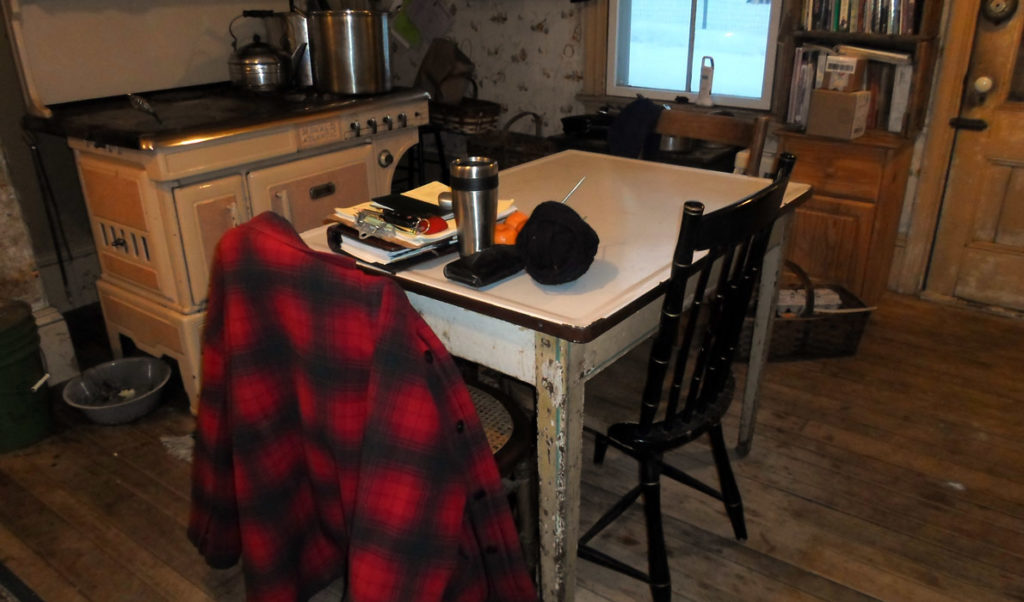Obviously, I like islands. I live on one and find that I like to vacation on them—Cyprus, England, the Orkneys off Scotland’s north coast, Hawaii, Nova Scotia and Cape Breton, Newfoundland, Key West, St. John in the Virgin Islands, and I aspire to visit Iceland.
I just don’t like islands in kitchens, those big wood and too-often granite topped blocks of immovability that one has to skate around to get to a fridge, or a pantry, or the phone.
I saw one island here that had a footprint the size of the average bathroom. The kitchen itself was a bit preposterous anyway. I’ve seen catering kitchens half the size. Actual cooking space and prep area can be quite compact; to cater, what you really need is a walk-in cooler and a honking six- to eight-burner gas stove, and depending on your business, convection ovens.
You don’t need an island as big as a tiny house.
That is not to say that it isn’t a good idea to have a surface behind you about two feet away from a stove top, where you can mix, assemble, then turn to the stove and back again. The most sensible islands have sinks in them, and storage, and they are fairly narrow, more like peninsulas at low tide.
Islands that have a shelf-like thing that you can sit at like a bar fly on a stool remind me of cooking shows where participants perch to cheer the cook on.
Instead of an island, I use an old enamel-topped kitchen table with drawers in it that I found in the barn when we moved here and brought in to use temporarily about 30 years ago. I keep chairs around it except on the stove side, and I use it for prep space, eating, writing notes, socializing, and as a place to jog kinetic memory.
On the evening before a mainland trip, it is where I stack my shopping list, thermos, check book, car key, knitting, anything I might need next morning when I am too foggy to think clearly before heading to the boat.
It is also constantly at risk for becoming a dump station. Come in the kitchen door and drop whatever you have in your hands—the mail, meeting notes, slice of cold pizza, a trowel, mittens. You know—everyone has such a spot in their homes. I would venture a guess that the bigger an island, the greater the capacity, and probably inclination, for dumping.
The difference between my kitchen table and an island is that mine is moveable, a kind of floating island. If I need more room, I can put a folding table next to it. I can shift it around, if necessary butt it up to a kitchen counter, drag it outdoors for al fresco service. Flexibility is the key.
But not too much flexibility. I had a friend with a smallish work table on wheels that she used like an island. Once I trustingly leaned against it and the island went skittering across the floor and I landed in the drink. “Oh, I forgot to lock the wheels,” she said. I forgot to look to see how well the island was anchored.
Those little cart-like islands risk being just about big enough to roll out a pie crust and seem designed only to make it possible for its owner to claim island-ownership; they strike me as the kitchen equivalent of those cartoon islands that have one palm tree, one survivor, and barely enough room to sit.
When I was growing up, it seems to me that I recall visiting my parents’ friends and my aunts and uncles. It seems to me that we sat around the kitchen table for coffee and cookies and the grown-ups talked while any children rollicked around the house or opened up the old family toy box to see what they might find for amusement. (Do modern grownups still keep a toy box for their child visitors?)
Sometimes, a framed embroidered or painted motto on the wall said, “No matter where I serve my guests, they seem to like my kitchen best.” But we weren’t stranded on a kitchen island.
I suppose it is hopelessly nostalgic to remember kitchen tables so fondly and find kitchen islands so obtrusive. Friends come over for coffee or tea, or even supper, and we sit around my kitchen table, facing one another, on chairs that support our backs, our feet on the floor. I can put a tablecloth on it to make an occasion a little special. Tables are friendly and work.
Sandy Oliver lives, writes, cooks, and gardens on Islesboro.





